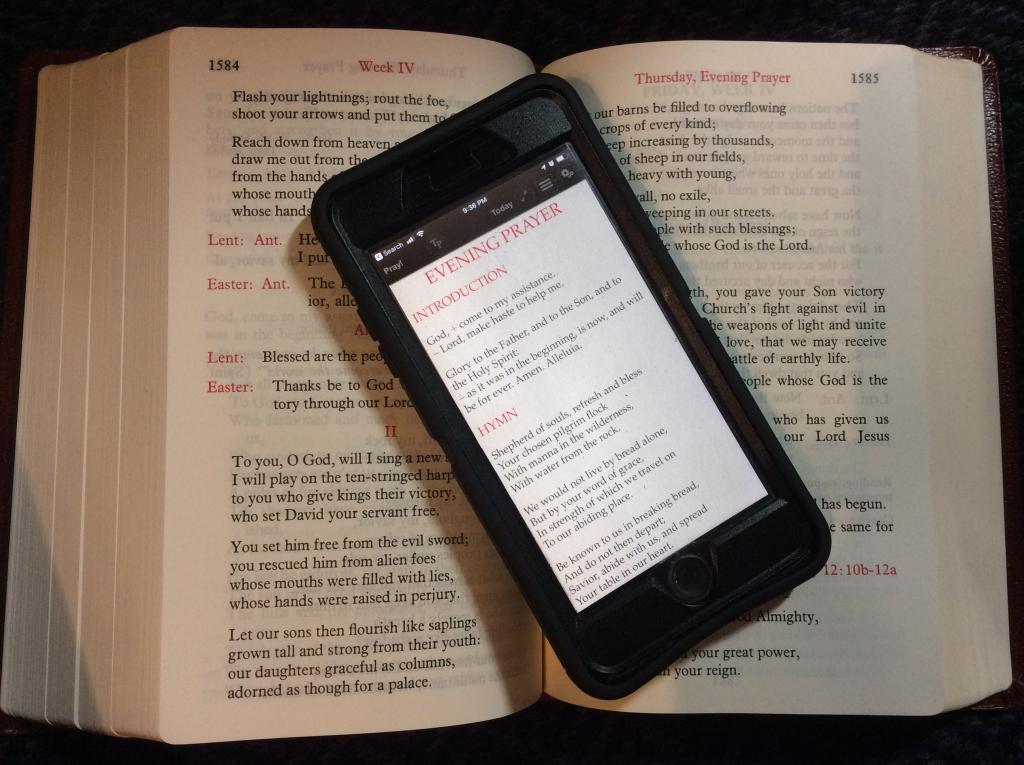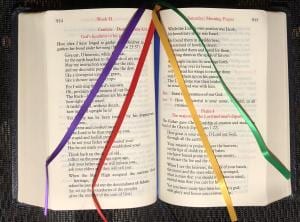
I believe that anyone who is serious about embracing the Christian contemplative path needs some form of sustainable daily prayer. For most of Christian history, this has meant using a breviary — a prayer book which contains prayer “services” or offices for praying throughout the day. Such collections of prayers are known as The Liturgy of the Hours or The Daily Office or The Divine Office.
The Liturgy of the Hours is the structure of prayer that nearly all Christian monasteries follow. There are different liturgies for different traditions within Christianity (Orthodox, Catholic, Anglican) and for different religious communities within the various churches (Benedictine, Cistercian, Carmelite, and so forth). In our day, even some Protestant, Reformed, and Evangelical versions of the Liturgy of the Hours has been published, which is remarkable since many of the faith communities in the evangelical world tend to avoid formal types of prayer.
But the Daily Office is a practical way to pray — even for people who don’t like to pray out of a book. Why? For the same reason that musicians collect sheet music of songs. Yes, maybe they would rather play “from heart” or memory, but musicians understand that to grow as musicians, they need to learn a variety of different tunes, songs, melodies, styles of playing — and it just makes more sense to rely on written music to expand one’s musical repertoire.
Likewise, people who pray seriously (and regularly) might soon discover that, if they rely only on their own experience and their own vocabulary when praying, sooner or later their prayer all starts to sound the same. But if they turn to the great literature of prayer: the psalms, the canticles, great hymns, and written prayers composed and collected from throughout the ages — then over time, their “prayer lexicon” expands, and they develop a deeper and more nuanced voice for prayer.
Among other things, daily prayer books like The Liturgy of the Hours teach us how to pray.
“What Do I Do With All These Ribbons?”
 I recommend investing some money into one or more versions of the Divine Office. At the end of this post I list links to several of my personal favorite prayer books. Some are single volume collections of prayers, others run up to four volumes — the entire set consisting of almost 8000 pages of prayers! These books are designed to be used multiple times every day, day in and day out, year in and year out. Prayers are organized by the season of the year (Lent, Easter, Advent, Christmas, and so forth), with special prayers for days that commemorate key events in the life of Christ, or memorials for the lives of great saints and martyrs.
I recommend investing some money into one or more versions of the Divine Office. At the end of this post I list links to several of my personal favorite prayer books. Some are single volume collections of prayers, others run up to four volumes — the entire set consisting of almost 8000 pages of prayers! These books are designed to be used multiple times every day, day in and day out, year in and year out. Prayers are organized by the season of the year (Lent, Easter, Advent, Christmas, and so forth), with special prayers for days that commemorate key events in the life of Christ, or memorials for the lives of great saints and martyrs.
Which means — when we pray the Liturgy faithfully, day in and day out, it not only teaches us how to pray, but it also forms us in the knowledge and memory of the Christian faith.
But there’s a catch.
Every year, the calendar of the Christian year changes slightly. Sure, Christmas is always on December 25 and the feast of St. Teresa of Ávila is always on October 15. But Easter varies from year to year, calculated based on the first full moon after the spring equinox. The date of Easter determines the dates of other key dates — Ash Wednesday, Palm Sunday, Good Friday, and Pentecost being some of the big ones. And finally, since the alignment of days on the calendar and days of the week shift each year (this year February 11 is a Monday, next year it will fall on a Tuesday), there is always a shift in what prayers need to be prayed on which particular day.
So how is that managed?
Traditionally, breviaries (prayer books) include certain prayers that are prayed daily or almost daily (such as the Canticle of Zechariah and the Canticle of Mary, known respectively as the Benedictus and the Magnificat), others that are prayed in a rotation (such as the 150 Psalms, which are prayed over a two-week or four-week cycle) and then of course various prayers that are only prayed on rare occasions, usually linked to a particular saint’s day or feast day of the church year). There’s no way to organize all these prayers — so the prayer books rely on a series of colored ribbons that function as bookmarks. Each day before you begin praying, you mark the pages of the Psalms, canticles and prayers that you will be using. That way, when you are actually praying, you can quickly turn from page to page to find just the specific prayers you need for that particular day.
If it sounds like a lot of bother — that’s because it is.
People who pray regularly get the hang of using the ribbons. But for many people, the learning curve is cumbersome. They want to be praying, for heaven’s sake — not fooling around with ribbons in a book!
Fortunately, for those of us who are ribbon-challenged, technology has come to our rescue.
Apps for Daily Prayer
Several smartphone/tablet apps have been published that make praying the Liturgy of the Hours almost foolproof. You simply have to open the app, make sure it is set on the current day, and then find the particular prayers you want to prayer — Morning Prayer, Evening Prayer, or several of the other “offices” of the day.
Most of these apps are available free or for a minimal cost. Some may have a subscription service — particularly with audio files. Yes, thanks to smartphone technology, you can listen to the Liturgy of the Day in addition to (or instead of) merely reading the prayers. Definitely a blessing for people who are visually impaired.
My personal favorite is iBreviary but I also like Universalis. Both of these apps feature the Roman Catholic Liturgy of the Hours in English. If you are an Episcopalian or simply prefer Anglican liturgy, you can use an app called The Daily Office from Mission St. Clare (these links all take you to the Apple/iTunes App Store; but the Catholic apps can also be downloaded through Google Play and Amazon if your phone isn’t an iPhone).
Once you’ve installed the app, then you’re ready to pray. Make it a habit! Praying the Liturgy (in part or in its entirety) is not meant to replace silent prayer practices like centering prayer or the Jesus Prayer, or for that matter Lectio Divina. And of course, praying is never meant to replace being a compassionate or loving person. On the contrary — pray the Daily Office as a way to open your heart, so that the Holy Spirit can direct you into the heart of love.
Prefer Books to Apps? Here’s a Few to Get You Started
- The Liturgy of the Hours — the current official Roman Catholic daily office. Very traditional, gendered language, but poetic and deeply devotional. Available in several four-volume editions; this link takes you to the least expensive version.
- The Prayer Book Office — the daily liturgy from the Episcopal Book of Common Prayer. I guess most Episcopalians just use the Prayer Book, as this edition is now out of print — and used copies are expensive.
- Benedictine Daily Prayer: A Short Breviary — a lovely one-volume prayer book edited by Benedictine monks. One of a number of liturgies based on the usage of a particular monastic community.
- The Saint Helena Breviary — an inclusive language liturgy as used by the Episcopal Order of Saint Helena. A gorgeous book, and as a bonus — several of the canticles included are drawn from the writing of Julian of Norwich!
- Common Prayer: A Liturgy for Ordinary Radicals — this resource comes from the neo-monastic community of ecumenical Christians seeking to revive monastic spirituality in new ways for our time. This liturgy has a strong emphasis on social justice.
- Celtic Daily Prayer: Book One and Book Two — a two-volume breviary from the Northumbria Community in England, based on the spirituality of the Celtic Church.
Happy praying, my friends!
Enjoy reading this blog?
Click here to become a patron.














